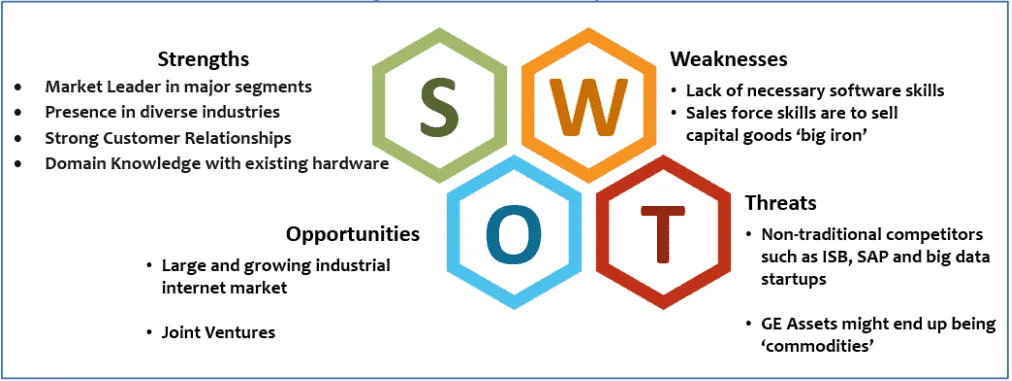GE and the Industrial Internet - Case Solution
GE and its CEO, Jeff Immelt, are looking into whether GE is moving quickly about its initiative regarding the industrial Internet. The industrial internet initiative covers machines and devices connection and data collection as well as operations in providing services to customers.
Case Questions Answered
- How would you assess GE and its Industrial Internet initiative?
- What are the next steps? What capabilities must GE invest in or develop over the next five years to accelerate Industrial Internet efforts?
- Who will be GE's most feared competitor in the next five years? Why?
1. How would you assess GE and its Industrial Internet initiative?
Necessary? Proactive? Valuable?
In the analysis done by the group, GE and its initiative in the industrial internet was necessary.
The following is the SWOT analysis for GE:

1. Large Market to be Capitalized – growth prospects:
The industrial internet revolution is a potential disruptor in the way corporates look at capital goods and procurement.
As per Analyst estimates, the Industrial Internet would create $14.4 trillion in economic value between 2013 and 2022, and technology spending by companies in these areas would be around $514 billion. GE, with its existing strengths of a large consumer base and strong customer relations, could capture a large share of this growing market.
2. Threat from non-traditional competitors:
GE is facing a threat from several non-traditional companies. These companies, such as IBM, SAP, and start-ups, are pitching analytics solutions to existing GE customers.
This might mean that GE products could end up as commodities, in a similar way that Microsoft’s Windows did to the PC industry. GE mainly faced an existential threat.
3. Stagnant stock prices:
In the last ten years, i.e., from 2001-2011, GE’s stock performance has been slow as compared to the likes of Siemens and IBM. GE needs good growth prospects in the future.
To summarize, this opportunity was one that GE could not afford to lose out on, and hence, it was necessary. Looking in hindsight, GE was able to generate higher margins (~65%) vs. conventional margins (~35%); hence this also proved valuable.
In our evaluation, this move was not precisely proactive because this was their reaction to the non-traditional competitors.
2. What are the next steps? What capabilities must GE invest in or
develop over the next five years to accelerate Industrial Internet efforts?
GE would broadly need the following capabilities:
- Design a common platform: Software was often customized for local conditions. Moreover, all products had a different platform. To succeed as a provider of industrial internet, GE had to ensure that there was a common platform for all GE businesses and a common language. A central software design team must engage with all companies to develop a common platform.
- Software Development: The customer needs were changing very rapidly. On the contrary, the current team would…
Complete Case Solution
Get immediate access to the full, detailed analysis
- Comprehensive answers to all case questions
- Detailed analysis with supporting evidence
- Instant digital delivery (PDF format)
Secure payment • Instant access
By clicking, you agree to our Terms of Use, Arbitration and Class Action Waiver Agreement and Privacy Policy